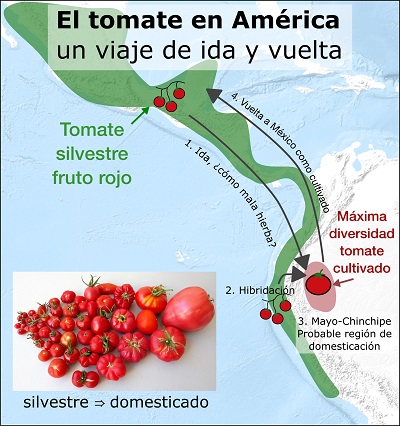The tomato domestication involved agricultural societies from Peru to Mexico
The whole genome of 628 wild and cultivated plants have been analyzed to unravel some details of the complex American tomato history.
[ 28/02/2022 ]
The plants we eat have been domesticated. There are no wild chihuahuas, in the wilderness there are wolves and, likewise, there are no wild big and juicy tomatoes, bread wheat or popcorn maize in the wild. Our forebears modified these species to adapt them to their needs, uses, and tastes. The tomato was domesticated by native american cultures thousands of years ago. Unfortunately, there are few tomato archeological remains and many questions to answer. Although some of these issues have been discussed for decades, most of them still have no final answers. For instance, it has been proposed that the domestication could have been carried out in Mesoamerica, the region comprising Mexico and Central America, or, alternatively, in Peru and Ecuador, but there has been no definitive evidence capable of settling the debate.
The plant genomic group at COMAV, a research institute located in theUniversitat Politècnica de Valènca in Spain, in collaboration with researchers from The University of Georgia are publishing in Horticulture Research new findings obtained within Varitome, a National Science Foundation funded project (NSF1564366) . The whole genome of 628 wild and cultivated plants have been analyzed to unravel some details of the complex American tomato history.
Most of the contemporary cultivated tomato is very similar to the wild Mesoamerican plants (Solanum lycopersicum var. cerasiforme), however, in its domestication there were also involved wild Ecuadorian and Peruvian species (S. pimpinellifolium). This complex scenario has hampered the study of the tomato domestication for decades, but, thanks to a novel statistical analysis developed for this research, it was possible to find out that although the domestication process started with the Mesoamerican materials, it was quite complex. In a first step, Mesoamerican plants migrated southward to a region located between the Andes foot and the Amazonian forest in Peru and Ecuador. This humid region is known as Ceja de Montaña. This migration was fast and very likely due to the commercial relationships established between different Mesoamerican and Ecuadorian and Peruvian cultures. More recently, some plants, very similar to the ones still grown in Southern Ecuador and Northern Peru, migrated back to Mexico. Surprisingly, the vintage Yucatan tomatoes are more similar to the Peruvian and Ecuadorian Ceja de Montaña ones than to its wild counterparts found in Mexico. Thus, it has been established that some wild tomatoes migrated southward and, then, went back as cultivated.
Moreover, these voyages would change the tomato forever. The growers from Ceja de Montaña did not use pure Mesoamerican plants, but admixtures created crossing the newly arrived plants with wild plants from coastal Peru and Ecuador. It is also there, in Southern Ecuador and Northern Peru, in the region located between Mayo and Chinchipe, where the highest genetic diversity of cultivated tomatoes in the world have been found, and it might be there where the domestication took place. However, to have a final confirmation regarding this question new archeological tomato remains could be needed.
The hybridization between Mesoamerican and Ecuatorial plants was used to take genes needed to adapt the northern tomatoes to the climate and latitude of Ecuador. Without this old hybridization it is unlikely that the tomato could have been easily adapted to climates as different as the Ecuadorian forests and the Mediterranean coasts.
The American tomato history was complex and included very distant agricultural cultures that adapted the crop to their needs and tastes. Like any other crop, the cultivated tomato was created by the genetic modifications fostered by its first growers. In the Americas the tomato was a secondary crop used mainly to prepare sauces. However, this was not the end of its trips, but only the beginning. For instance, after arriving in Europe different varieties were created, and it wasn’t until the industrial revolution that the crop acquired its current relevance. Nowadays we are still creating new varieties adapted, again, to our needs, uses, and tastes. The native american growers defined the past of the tomato, and it is our shared task to define its future. We change the plants we grow, and they, in turn, define us.
Outstanding news
 The Diamond Army
The Diamond Army
Two students came up with the UPV initiative that has engaged more than 1,600 volunteers and shattered the false myth of the 'crystal generation'
 ARWU 2024
ARWU 2024
The Shanghai ranking reaffirms the UPV as the best polytechnic in Spain for yet another year
 Distinction of the Generalitat for Scientific Merit
Distinction of the Generalitat for Scientific Merit
Guanter has been distinguished in recognition of his research excellence in the development of satellite methods for environmental applications
 The new statutes come into force
The new statutes come into force
The Universitat Politècnica de València is the first university in Spain with statutes adapted to the new LOSU
 NanoNIR project against breast cancer
NanoNIR project against breast cancer
UPV Researcher Carla Arnau del Valle receives an EU Marie Curie grant to develop biosensors for the early detection of this cancer
 Large artificial intelligence language models, increasingly unreliable
Large artificial intelligence language models, increasingly unreliable
According to a study by the Universitat Politècnica de València, ValgrAI and the University of Cambridge, published in the journal Nature





